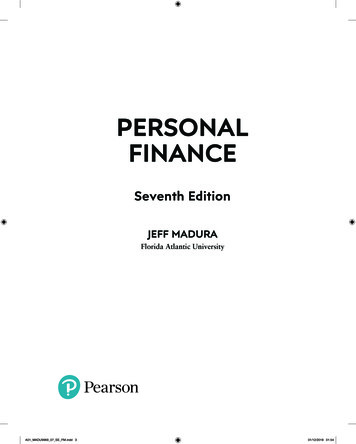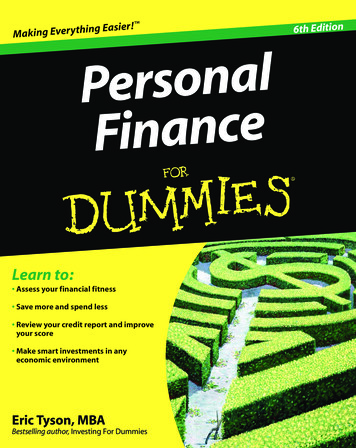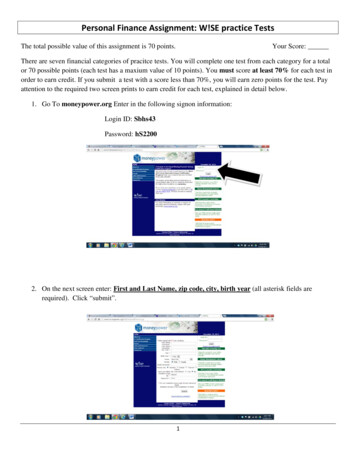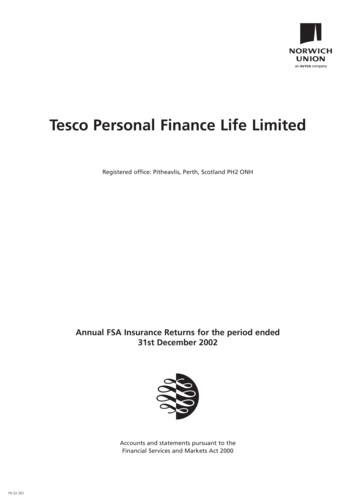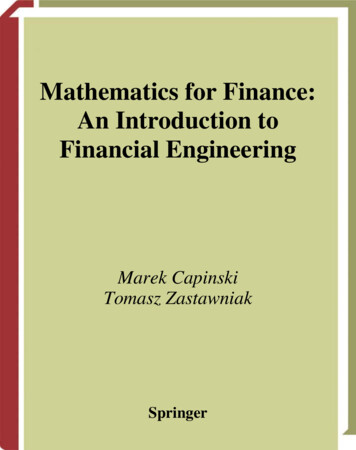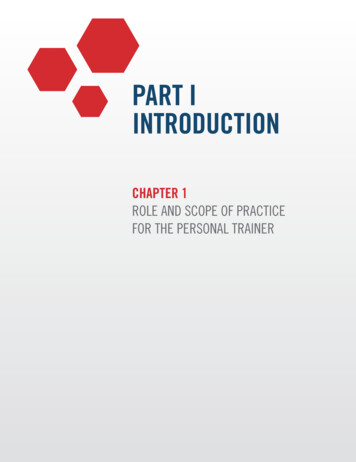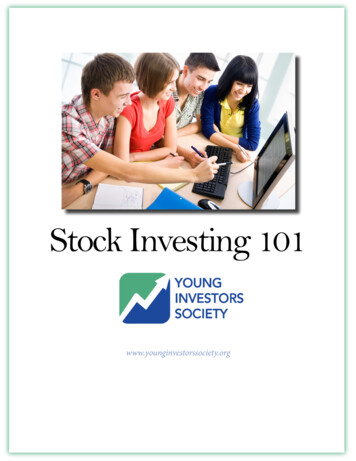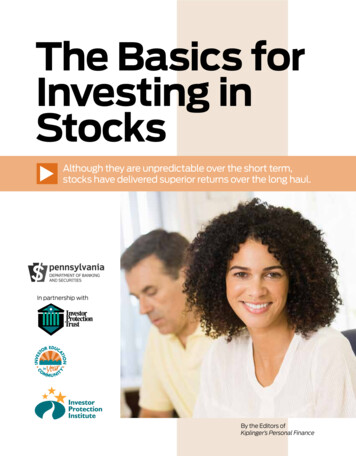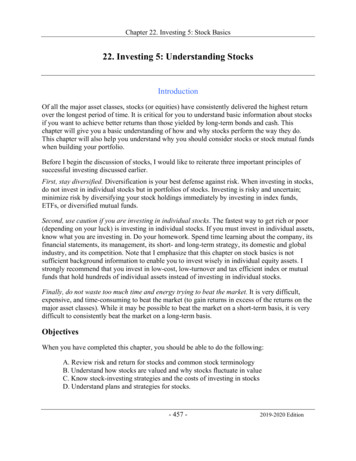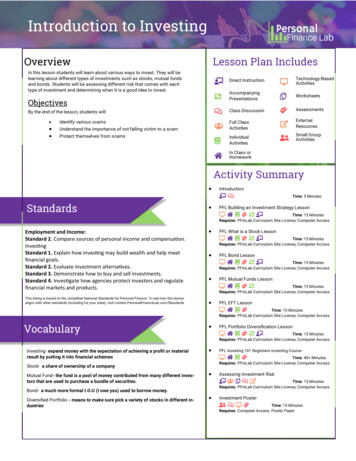
Transcription
Introduction to InvestingOverviewLesson Plan IncludesIn this lesson students will learn about various ways to invest. They will belearning about different types of investments such as stocks, mutual fundsand bonds. Students will be assessing different risk that comes with eachtype of investment and determining when it is a good idea to invest.ObjectivesBy the end of the lesson, students will: Identify various scams Understand the importance of not falling victim to a scamProtect themselves from scamsDirect resentationsWorksheetsClass DiscussionAssessmentsFull ClassActivitiesExternalResourcesSmall GroupActivitiesIndividualActivitiesIn Class orHomeworkActivity Summary IntroductionTime: 5 MinutesStandards Employment and Income:Standard 2. Compare sources of personal income and compensation.InvestingStandard 1. Explain how investing may build wealth and help meetfinancial goals.Standard 2. Evaluate investment alternatives.Standard 3. Demonstrate how to buy and sell investments.Standard 4. Investigate how agencies protect investors and regulatefinancial markets and products. This listing is based on the Jump tart National Standards for Personal Finance. To see how this lessonaligns with other standards (including for your state), visit content.PersonalFinanceLab.com/StandardsPFL Building an Investment Strategy LessonTime: 15 MinutesRequires: PFinLab Curriculum Site License, Computer AccessPFL What is a Stock LessonTime: 15 MinutesRequires: PFinLab Curriculum Site License, Computer Access PFL Bond LessonTime: 15 MinutesRequires: PFinLab Curriculum Site License, Computer Access PFL Mutual Funds LessonTime: 15 MinutesRequires: PFinLab Curriculum Site License, Computer Access PFL EFT LessonTime: 15 MinutesRequires: PFinLab Curriculum Site License, Computer AccessVocabularyInvesting- expend money with the expectation of achieving a profit or materialresult by putting it into financial schemes Time: 15 MinutesRequires: PFinLab Curriculum Site License, Computer Access Assessing Investment RiskTime: 15 MinutesRequires: PFinLab Curriculum Site License, Computer AccessBond- a much more formal I.O.U (I owe you) used to borrow money.Diversified Portfolio - means to make sure pick a variety of stocks in different industriesPFL Investing 101 Beginners Investing CourseTime: 40 MinutesRequires: PFinLab Curriculum Site License, Computer AccessStock- a share of ownership of a companyMutual Fund- the fund is a pool of money contributed from many different investors that are used to purchase a bundle of securities.PFL Portfolio Diversification Lesson Investment PosterTime: 15 MinutesRequires: Computer Access, Poster Paper
2Instructor’s GuideIntroductionAsk students if they know what the term investing means?Explain:Investing- expend money with the expectation of achieving a profit or material resultby putting it into financial schemesExplain: There are many different types of ways to invest. It is important to know about all thedifferent ways to invest in order to get the most money out of your investments.Time:5 MinutesType:Required Resources:Explain: Some types of investments include stocks, bonds, mutual funds, real estate, Cash.Explain: Today we will be learning about a few different types of investments and we will beassessing the pros and cons to each investment type.Independent ActivitiesActivities designed for students to learn independently—either in class or as homework. Some activities include presentationsif you prefer to use them for direct instruction instead of independent study.PFinLab Building an Investment Strategy LessonTime:15 MinutesAssign your students the “Building an Investment Strategy ” lesson on PersonalFinanceLab.com.This lesson breaks different types of investments (Cash, Stocks, Bonds.) down and quicklyexplains to students the liquidity, risk and potential growth that comes with each type ofinvestment. It also gives students tips and tricks that come with investing.Type:Students will be required to complete the quiz at the end as an assessment. If used ashomework, follow up with discussion questions the next day.Discussion Questions: What does the word liquidity mean? Do you think that there is a best type of investment? Why? What is one tip or trick that you got from this article?Resource Links:Lesson Content (Included in the Assignment on estingstrategy/Accompanying entation/Introduction to InvestingRequired Resources: PFinLab Curriculum Computer Access
3Instructor’s GuidePFinLab What is a Stock LessonTime:15 MinutesAssign your students the “What is a Stock” lesson on PersonalFinanceLab.com. This lesson is anintroduction to stocks. The lesson goes into detail about all the different things and terms thatare involved with stocks. Students will also learn how to make a stock trade on thePersonalFinanceLab.com.Type:Students will be required to complete the quiz at the end as an assessment. If used ashomework, follow up with discussion questions the next dayDiscussion Questions: What is a stock? What benefits come with stocks? Where can you buy a stock?Required Resources: PFinLab Curriculum Computer Access Resource Links:Lesson Content (Included in the Assignment on ancelab.com/beginners/stocks/Accompanying ab Bond LessonTime:15 MinutesAssign your students the “Bond” lesson on PersonalFinanceLab.com. This lesson is anintroduction to bonds. The lesson goes into detail about all the different things and terms that areinvolved with bonds. Students will also learn how to make a bond trade on thePersonalFinanceLab.com.Type:Students will be required to complete the quiz at the end as an assessment. If used ashomework, follow up with discussion questions the next dayDiscussion Questions: How are bonds different from stocks? Why would a government issue out a bond?Resource Links:Lesson Content (Included in the Assignment on ancelab.com/glossary/a-g/bond/Accompanying m/presentations/bonds-presentation/Introduction to InvestingRequired Resources: PFinLab Curriculum Computer Access
4Instructor’s GuidePFinLab Mutual Fund LessonTime:15 MinutesAssign your students the “Mutual Fund” lesson on PersonalFinanceLab.com. This lesson is anintroduction to mutual funds. The lesson goes into detail about all the different types of mutualfunds and the benefits that come with each type. Students will also learn how to make a mutualfund trade on the PersonalFinanceLab.com.Type:Students will be required to complete the quiz at the end as an assessment. If used ashomework, follow up with discussion questions the next dayDiscussion Questions: Explain the different types of mutual funds? What type of person would invest in a mutual fund? Why?Required Resources: PFinLab Curriculum Computer AccessResource Links:Lesson Content (Included in the Assignment on ancelab.com/beginners/mutual-funds/PFinLab ETF LessonTime:15 MinutesAssign your students the “Portfolio Diversification” lesson on PersonalFinanceLab.com. Thislesson is an introduction to Exchange Traded Fund. The lesson goes into detail about all thedifferent types of ETFs and the benefits that come with each type.Type:Students will be required to complete the quiz at the end as an assessment. If used ashomework, follow up with discussion questions the next day.Required Resources:Discussion Questions: Name and define two types of ETFs. How is an ETF different than a mutual fund?Resource Links:Lesson Content (Included in the Assignment on roduction to Investing PFinLab Curriculum Computer Access
5Instructor’s GuidePFinLab Portfolio Diversification LessonTime:15 MinutesAssign your students the “Portfolio Diversification” lesson on PersonalFinanceLab.com. Thislesson addresses the importance of having a diversified portfolio. The lesson explains thedifferent ways that you can diversify your portfolio as an investor.Type:Students will be required to complete the quiz at the end as an assessment. If used ashomework, follow up with discussion questions the next day.Required Resources:Discussion Questions: Why is it important to diversify your portfolio? Provide an example of how to diversify. What are some problems that you can face if you over diversify? PFinLab Curriculum Computer AccessResource Links:Lesson Content (Included in the Assignment on companying ion/PFinLab Investing 101Time:40 Minutes Per ChapterAssign your students chapters from the Investing101 course on Personal Finance Lab. Thesechapters are designed as a self-guided beginners investing course, to be used as a supplement tothe stock game, or as an extra resource for students who are interested in learning more aboutinvesting on their own.Type:Chapters 1-3 cover investment basics. These can be replaced with the other lessons found in thislesson plan. Chapters 4-10 cover more intricate details on how to research investments, readstock charts, and understand different levels of risk.Each chapter has, on average, 10 mini-lessons, concluding with a “chapter exam” as anassessment.Each chapter can be selected separately as part of an “Assignment” on Personal Finance Lab,and is best used as an “extra” to the stock game (so students progress through the course duringclass time also reserved for managing their stock portfolios) or as an independent/extra creditexercise as homework.Resource Links:Lesson Content (Included in the Assignment on ancelab.com/investing101/Introduction to InvestingRequired Resources:PFinLab Site License
6Instructor’s GuideFull Class ActivitiesActivities designed for whole-class participation. These are best used along with the direct instruction portion of the lesson.Assessing Investment RiskIn this teacher lead activity, students will be learning about the different levels of risk that comewith each different type of investment.Pass out worksheetExplain to students that for this activity they will be assessing the risk that comes with each typeof investment.Give students 3 minutes to list out as many different types of investments that they can on theback of the worksheet.After the 3 minutes go around the classroom and ask students what they came up with. Write thedifferent answers on the board.Here is a list of possible solutions (add as many extras that you see fitting): Aggressive Growth Stocks - Corporate Bonds - FuturesGov’t Securities/Bonds - Aggressive Growth Mutual Fund - Real EstateU.S. Savings Bonds - Aggressive Growth Bonds - Savings Account - CashHigh Quality Stocks - High Quality Mutual Funds - Money Market Funds - Certificateof DepositOnce you have the list written on the board, have students label the chart: High RiskMedium RiskLow RiskAsk them what they think the risk level is of investing in Cash?Explain that the only risk is inflation which occurs for everything so that would be at thelowest level.Next ask them where they think mutual funds would go?Explain that mutual funds have some risk since they rely on the market. So it would beplaced in the middle group.Have students work in pairs or alone to finish the rest.After the students have finished the list, show them an example of a finished chart and have themcheck their answers.Ask if any students have any questions and collect the worksheet.Resource on to InvestingTime:20 MinutesType:Required Resources: Worksheet
7Instructor’s GuideSmall Group ActivitiesActivities designed for small groups of students. These resources are best used after full-class direct instruction andactivities.Investment PostersTime:15 MinutesIn this activity students will be working in small groups to asses different types of investmentsand making a poster for the class to educate the class on the investment idea.Type:Put students in groups of 3-4Assign each group an investment type (it is okay if groups have the same type: StocksBondsMutual FundsCertified DepositsReal EstateCashGive each group a piece of poster paper and have them research the following information: DefinitionAverage CostLiquidityRiskHow long people hold itPro and ConsExampleFun/ Interesting FactVolubilityOnce groups have finished their posters, have them present it to the class.Hang posters up in the classroom.Introduction to InvestingRequired Resources: Poster Paper Computer Access
8Instructor’s GuideConclusionRemind students about the importance of knowing the different types of stocks.Remind students why it is important to have a diversified portfolio.Briefly ask students to define: Stock Bond Mutual Fund EFTIntroduction to Investing
9Instructor’s GuideResource PageIntroduction to Investing
chapters are designed as a self-guided beginners investing course, to be used as a supplement to the stock game, or as an extra resource for students who are interested in learning more about investing on their own. Chapters 1-3 cover investment basics. These can be replaced with the other lessons found in this lesson plan. Chapters 4-10 cover .

